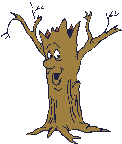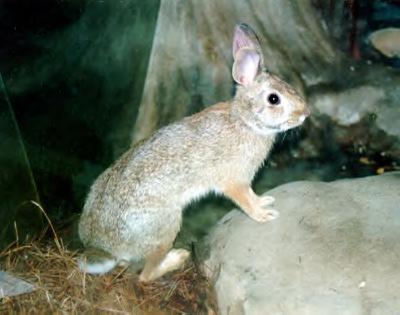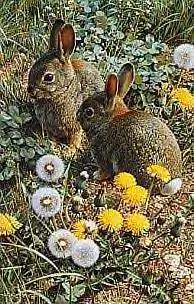|
|
Canku Ota |
|
|
(Many Paths) |
||
|
An Online Newsletter Celebrating Native America |
||
|
april 21, 2001 - Issue 34 |
||
|
|
||
|
How Rabbit got his Cotton Tail |
||
 Long, long ago,
Rabbit had a long, busy tail like other animals. Long, long ago,
Rabbit had a long, busy tail like other animals."I have the most beautiful tail in the world," he liked to say. Rabbit was feeling very excited one day. All around him snowflakes floated like feathers. He ran through the flakes. And, he darted around the Willow Tree. "Look at me," he laughed. "When I run, my tail is more beautiful than ever." Rabbit ran and ran and sang," "It snows! It snows! If only it keeps snowing, I will run and run and run!!" And that's just what Rabbit did. The faster the snow fell, the faster Rabbit ran. Rabbit, with his beautiful, bushy tail, ran all day long. The snow got deeper and deeper. Finally, it began to get dark. Rabbit looked for a place to rest beneath a bush. But so much snow had fallen, that all the bushes were hiding under it. Rabbit stood on top of the pile of snow.  "Look at me! Now, I am as tall as the Willow Tree." "Look at me! Now, I am as tall as the Willow Tree."Then Rabbit laughed and said, "I am so tall that I can reach Willow Tree's green buds." Because Rabbit was hungry, he nibbled one of the buds. Then, he nibbled another one. "Yum Yum!!" Rabbit ate and ate until his belly was very round. Then he laid down on a branch and fell asleep in the Willow Tree. Rabbit was so tired from all of his running, that he didn't wake up when Sun rose over the hills. He didn't wake up when Sun's hot rays melted the snow. He didn't wake up until all the snow was gone. Then, Rabbit opened his eyes wide. He looked down at the ground. "Where are the flakes that look like feathers? Where is that deep, deep snow?" Spring had arrived. On the ground, all of the tasty plants had turned green. But there was Rabbit, stuck high in the Willow Tree.  "A rabbit shouldn't be in a tree like a bird," he said, "A rabbit should be on the ground with the tasty plants." But, the ground was very far away. Rabbit leaned over to look down. But, he leaned too far and fell out of the Willow Tree. He landed on his paws, then head first on the ground. When Rabbit landed on his front paws, they became short. When he landed on his head, his lip split in two. BUT, worse of all, when Rabbit fell through the tree, his tail got caught in the branches. Rabbit looked up from the ground. "OH NO!!" cried Rabbit. "I've lost my beautiful, long, fluffy tail!" And sure enough, Rabbit's tail was high above. It hung from the very top of the Willow Tree.  Poor Rabbit. He tried and tried, but he just couldn't reach his beautiful tail. Now, Rabbit, and all of his grandchildren hop-hop-hop on short front legs. Now, rabbits have split lips and very short tails Now the Pussy Willow grows lots and lots of little rabbit tails on her branches to let us know that spring has come. And to remind us what can happen if we are too proud, like Rabbit was about his tail. And, now, rabbits never, never climb trees. |
|
Print and Color Your Own Rabbit: |

 Eastern
Cottontails are the best-known and most widely distributed rabbit of North America.
Eastern
Cottontails are the best-known and most widely distributed rabbit of North America.  Cottontails are blind at birth and their eyes remain closed until they
are about a week old. Baby rabbits leave the nest and can survive on their own by the time they are 3 to 4 weeks
old. Eastern Cottontails are most likely to be found In and around old, overgrown fields, brushy forest edges and
other habitats with mixtures of herbaceous and shrubby plants. They can also be found living in close proximity
to humans as long as there is adequate escape cover available.
Cottontails are blind at birth and their eyes remain closed until they
are about a week old. Baby rabbits leave the nest and can survive on their own by the time they are 3 to 4 weeks
old. Eastern Cottontails are most likely to be found In and around old, overgrown fields, brushy forest edges and
other habitats with mixtures of herbaceous and shrubby plants. They can also be found living in close proximity
to humans as long as there is adequate escape cover available.